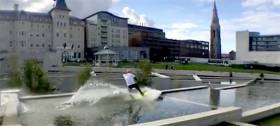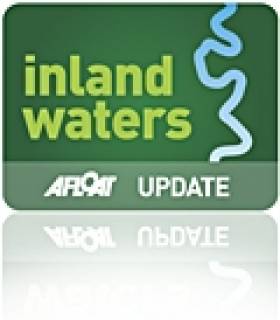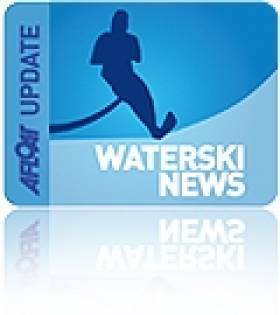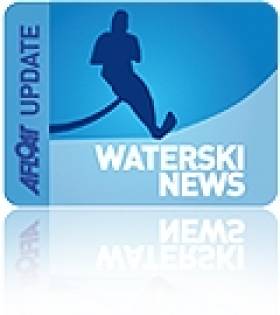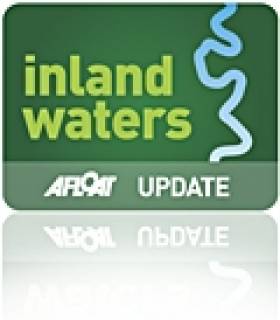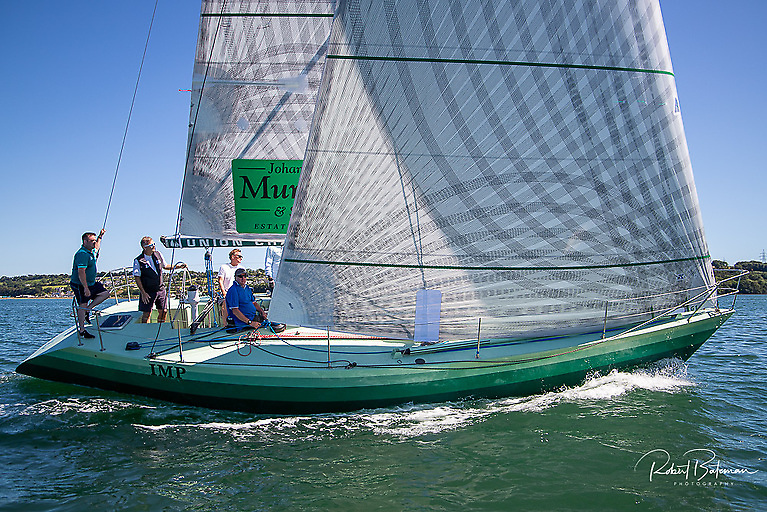Displaying items by tag: wakeboarding
Wakeboarder Skiing At Dun Laoghaire Lexicon
Dun Laoghaire Library is the newest wakeboard venue in Ireland, according to pro boarder David O'Caoimh. The Killiney man turned the fancy South Dublin amenity into Ireland's wakeboarding cable park in February and captured it on video below.
The Dun Laoghaire Library/ Lexicon cost the Irish Tax Payer 36.6 million, and led to a lot of controversy!I never thought I would get any value from it as a tax payer, until today when I realised I could go wakeboarding there. Thanks to the Dún Laoghaire-Rathdown County Council for building such great Wakeboarding spots!
Posted by David O'Caoimh Wakeboarder on Sunday, 28 February 2016
The champion boarder rigged up his own electrically–driven cable tow rope, and got right to it, in the library's new water feature!
But the water may have been too cold for O'Caoimh. The Irish champion has since moved on to to an adventure at Xtreme-gene in Spain, where the 'lake is like glass' and probably a lot warmer too.
'Man, It Feels Good to be Back Shredding' , he told friends on social media and posted this video below.
#Docklands - World-class wakeboarding comes to Dublin's Grand Canal Dock this weekend (16-17 May) at the Waterways Ireland Docklands Summer Festival 2015.
Prepare to be wowed as the world's best wakeboarders showcase an array of grabs, spins and tricks, including European champion Carro Djupsjo from Sweden, British champion Meg Barker and Irish champion David O'Caoimh.
Organised by the Docklands Business Forum, the festival attracted over 60,000 visitors across the two days in 2014, with an even greater attendance expected this year.
The weekend will see an abundance of entertainment and competitions on both the water and the land. With everything from open air DJs, water sport come-try-it-sessions, a water golf challenge (with floating golfing green) to the tricky FM104 Corporate Raft Challenge, there will be plenty in store for a fantastic day.
The world-class wakeboarding demonstrations will feature a first ever for Ireland, with the public voting for the best performer through the unique DockFest15 voting app and big screen.
And there's lots on offer for the kids too including a 'rubber ducky' race, a children's arts centre at the Waterways Ireland Visitor Centre, a family funfair, champion street performers and international food markets.
For more visit www.docklandssummerfestival.com.
Increase in Water-skiing and Wakeboarding Participation Says Federation of Irish Sport
#waterski – Among the highlights made in today's Federation of Irish Sport annual review is a report that participation in water-skiing and wakeboarding increased from 3,000 to 8,500 at a time when many other water based sports, such as sailing, face a decline in numbers.
The Federation has called on the Government to make some beneficial New Year sporting resolutions to extend the tax relief for sporting bodies beyond capital projects to include day-to-day spending, as well as to allocate a portion of betting tax receipts for the development of all sports and not just horse and greyhound racing as is the case currently. The calls were made as the Federation, the representative association for National Governing Bodies of Sport, published its Sixth Annual Review of Irish Sport, highlighting the huge sporting contribution Ireland's National Governing Bodies and Local Sports Partnerships have made to Irish life during 2014.
The Federation strongly believes that the measures put forward, in addition to the development of a cross-government National Sports Strategy, would serve to significantly enhance the sustainability of sporting activities in Ireland and to copper-fasten the contribution sport makes to community life, public health, the economy, and to Ireland's reputation at home and abroad.
Brogan Calls for New Funding Initiatives
While welcoming recent Government commitments in relation to the funding of sport, Bernard Brogan, President of the Federation of Irish Sport and Dublin GAA star, is urging a number of new funding initiatives that would future-proof its viability:
"It is clear that sustained Government investment in Irish Sport is paying off with 47.2 per cent of Irish people now participating in sport1, up from 30.8 per cent in 20082. The increase in participation rates has been reflected in the success of Irish athletes on the international stage—across all sports at all levels—with Irish athletes having so far won a total of 241 medals between 2011 and 20143, compared with just 65 medals from 2007 to 20104.
"However, while it is welcome that the level of funding for the Irish Sports Council has been maintained at €42.5 million and an additional €1 million has been allocated for preparations for the Rio Olympic and Paralympic Games in 2016—and we acknowledge the efforts of Ministers Donohoe and Ring in this regard—this is from a point where there has been a 27 per cent reduction in funding levels since 2008. It is clear that more can be done to sustain the sector in supporting people's health and well-being, in enhancing our social fabric and in growing our economy. That is why the Federation is today calling on the Government to give serious consideration to affording tax relief to the day-to-day spending of sporting bodies, beyond capital spending as pertains now, as well as including all sports—and not just horse and greyhound racing—in the allocation of development funding from betting taxes."
Need for National Sports Strategy
Sarah O'Connor, Chief Executive, Federation of Irish Sport, believes a masterplan for sport is critical for its future development:
"Irish sport supports 40,000 jobs in the economy5, contributes 2.4 per cent to GDP6 and stimulates €1.9 billion in household spending7 and €650 million in overseas tourism spending8. It is the single biggest contributor to active citizenship with almost 500,000 adults volunteering in sport each year9, with the economic value of this voluntary workforce estimated at €1.3 billion10. Almost nine in ten Irish people believe that sport has a positive impact on the country's reputation11. It also has a huge effect in combating the significant public health challenges posed by obesity with 89 per cent of highly active people more likely to report both their weight and diet as healthy12.
"Sport plays such a huge part in the development of our society and we need to maximise its true potential for everyone's benefit. It is only when there is an All-of-Government commitment and approach to sport that its rich and varied dividend can be maximised. That's why sport needs new and strategic thinking and this can best be achieved through the development of a cross-Government National Sports Strategy."
2014 Federation Key Sporting Highlights
The role of Ireland's National Governing Bodies and Local Sports Partnerships are critical to the future of sport and the Federation's Annual Review sets out just some of the returns that these organisations have made on the Government monies invested in them. Among the 2014 achievements were:
National and International Sporting Achievements
· Rory McIIroy won the British Open and United States PGA golf championships
· 30 medals were won by Irish boxers in European competitions in 2014 in addition to Katie Taylor's fifth World Championship Title
· Ireland's Women's Rugby Team become the first Irish team to beat the All Blacks while the men secured the RBS 6 Nations Title for only the second time
· The Football Association of Ireland secured the Euro 2020 Championship matches for Dublin
· 1,500 athletes took part in the Special Olympics World Games, supported by 3,000 volunteers
· The Golfing Union of Ireland and the Irish Ladies Golfing Union won their bid to host the International Golf Federation's World Amateur Team Championships to be staged in Carton House, Co. Kildare, in 2018, which will see more than 500 golfers compete from 80 countries
· 20,000 United States visitors attended the Croke Park Classic between the University of Central Florida and Penn State generating €30 million for the Irish economy
Sporting Body Achievements
· Athletics Ireland's female-to-male membership ratio is now 55:45 following the success of its Fit4Life initiative targeting female participation
· Badminton Ireland's Shuttle Time initiative resulted in 50,000 children now playing badminton in schools while, separately, 32 new badminton clubs were established
· Swim Ireland's inaugural Swim for a Mile event saw 1,200 people take part
· Triathlon Ireland's races during 2014 saw 50,000 participants get involved
· Cycling Ireland's membership increased by 21 per cent
· The Irish Wheelchair Association's sport programmes saw a 10 per cent increase in participation rates
· Canoe Ireland's International Liffey Descent was a great success with 800 participants taking part, including many visitors from overseas
· The GAA's Féile na nGael and Féile na nÓg festivals saw 15,000 children take part in 977 games over two weekends
· A record 1,100 women took part in the Ladies Gaelic Football's Annual Gaelic4Mothers Blitz
· 1,800 students from 127 teams took part in eight Student Sport Ireland leagues
Community Initiative Achievements
· 2,500 cyclists took part in Cork Sports Partnership's Rebel Tour
· 1,620 children took part in Fingal Sport Partnership's Primary School Athletics Final
· 3,000 people took part in Kerry Sport Partnership's Let's Get Kerry Walking
· 2,300 children took part in the University of Limerick's Sports Kids Run for Fun
· 400 women took part in Monaghan Sport Partnership's try an activity programme for those over 50
· The Tour of Sligo cycle race generated €450,000 for the local economy
· 500,000 people took part in recreational ice skating
· Participation in water-skiing and wakeboarding increased from 3,000 to 8,500
The Annual Review is available at www.irishsport.ie
Wakeboarding Gets Olympic Games Lift
#wakeboard – With Cable Wakeboard now shortlisted for inclusion in the 2020 Olympic Games, global growth of these low cost Wakeboard facilities continues to accelerate. In recent months alone, additional new Wakeboard parks have opened in France, Germany, Russia, Great Britain, USA, Turkey and Ukraine. Egypt will also join this global expansion with its first facility in the coming weeks. On the other side of the globe, the Cable Wakeboard World Championships will be staged this year at the DECA Wake Park in Clark in the Philippines on November 4/11.
In recognition of the rapid growth of Wakeboarding around the world, a major Cable Wakeboard facility has now been constructed at Beijing's Shunyi Olympic Aquatic Park. This electric powered Wakeboard facility introduces an environmentally friendly sport to this important area with an attractive return on investment which adds to its appeal. As this is already Asia's largest Watersports training base, Beijing area residents and visitors will be invited to attend the official opening ceremony early in the New Year.
First opened in July 2007, one year before the 2008 Beijing Olympic Games, the magnificent Shunyi Aquatic Park was designed for Rowing, Canoe/Kayaking, Marathon Swimming and Paralympic Rowing. Located just 30 minutes drive from downtown Beijing, an interesting feature provides for the water to be recycled every 35 to 40 days. With 60 countries on site competing for the 32 Olympic gold medals awarded at the lake in 2008, many will recall the great success of this first class facility at that time.
The International Waterski & Wakeboard Federation (IWWF) is currently preparing to present its case for the inclusion of Wakeboard in the 2020 Olympic Games at a meeting scheduled for Lausanne in Switzerland in December. The new Shunyi Cable Wakeboard facility is a very welcome addition to the global network of such facilities according to IWWF President, Kuno Ritschard.
Wakeboarding Video on Grand Canal Condemned
A video clip of youths wakeboarding on the Grand Canal on Ireland's inland waterways while being towed behind a car on the tow path has drawn the ire of water safety experts who say the actions are 'foolhardy' and 'irresponsible'. The youtube stunt is below with comments from viewers that includes one from a David Kilty who says: 'Good stuff lads at least someone is making use of our waterways'. The video has been forwarded to the Inspector of Navigation as Lt Cdr John Leech of Irish Water Safety believes the activity is in breach of the Grand Canal Act.


























